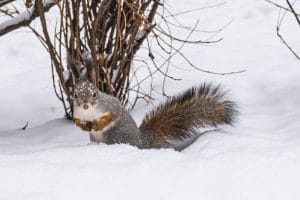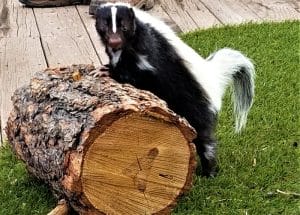Initially, the idea of wildlife strolling through your yard seems idyllic. Deer strolling across the grass, cute rabbits hopping through the garden, squirrels hovering around a well-stocked feeder: it’s like having a slice of nature on your property.
What’s not so appealing is when wildlife start laying claim to your home. Once raccoons and squirrels start tearing out the insulation in your walls and attic and mice begin treating your kitchen like an all-you-can-eat buffet, the cuteness factor is gone and you’ll start looking for humane wildlife eviction services.
We’re all animal lovers here at Bad Company Wildlife Eviction, so we’re more than happy to give you tips that prevent the need to call us. In this blog, we share tips for the best ways to keep wildlife out of your yard.
Start by Identifying Your Wildlife
The first step in keeping animals away from your yard (and your home) is determining what wildlife regularly visits your property. While you may see some of them, others are nocturnal or more secretive. Still, there are ways to detect their presence.
Rats
Droppings are one of the biggest indicators of a rat’s presence. Compared to mouse droppings, they have a different shape and size. Rats defecate often, with some being able to produce up to 40 droppings in a single night.
Other signs include:
- Bite Marks: Rats have strong teeth and can chew through material like wood, brick, plastic, cement, and aluminum. They leave distinct bite marks, and signs such as ripped food packaging and damaged wood or plastic materials confirm the presence of rats in your outbuildings.
- Nests: When rats multiply, they build nests in warm and dry places. Fabrics such as cloth, paper, and cardboard materials are attractive to rats as nesting material, so if you see it scattered in your yard, rats may be scoping your home. (In other words, time to look at ways to keep wildlife out of your yard!)
- Unusual Pet Activity: Cats and many dog breeds instinctively go after rats. If your cat or dog starts actively hunting for something in your backyard, you might be looking at increased rat activity.
Raccoons
When your lawn or mulch pile is full of holes, you probably have a nightly masked visitor, albeit one of the four-footed variety. Raccoons dig up lawns and mulch piles to hunt and consume insects, so dirt and debris in either area means they’re in the area. Other signs include:
- Disturbed Trash Cans: Raccoons are master foragers who love to dig through trash cans looking for food. If your cans are tipped over and bags ripped to pieces, they’re the likeliest culprits.
- Empty Bird Feeders: Bird feeders are loaded with seeds, suet, and other delicacies that raccoons love. If the contents of your feeder are disappearing quickly and you spot small tracks in the area (this might be easier to detect in winter), raccoons are likely doing a dine and dash.
- Emptied Gardens: If you have fruit trees or a vegetable garden, raccoons will be frequent visitors. Disappearing produce is another definite sign that someone is coming by for food (and that it’s time to keep wildlife out of your yard).
Squirrels
Like rats and raccoons, squirrels are attracted to food sources in your yard. This includes bird feeders, fruit trees, and vegetable gardens. They are also less secretive than rats or raccoons, so you’re more likely to see them out in the open, scurrying through the yard or running from tree to tree. If you’re seeing a lot of them as the weather gets colder, it may only be a matter of time before they start looking at your home as a place to hunker down for the winter.
Step-by-Step Tips to Keep Wildlife Out of Your Yard
Rats, raccoons, and squirrels are less likely to check out your yard if there’s no place for them to hide. Start by clearing away overgrown bushes and shrubs, wood piles, and equipment (e.g. wheelbarrows) that aren’t in use. Open spaces and neatly trimmed gardens and greenery tend to discourage them, especially rats and raccoons. Once you’ve got that done, move on to the steps below.
Eliminate Food Sources
One of the main reasons why wildlife visits your yard is to search for food. Getting rid of anything edible will go a long way when you’re trying to keep wildlife out of your yard. To get started, you can:
- Populate your garden with plants that raccoons and other animals don’t like
- Pick fruits and vegetables as soon as they are ripe and clear away any fallen fruit or tree nuts
- Don’t leave pet food or bird feeders out overnight
- Using lockable trash cans
Discourage Them
Putting deterrents in your yard can help scare away certain animals. If your dog spends a lot of time outside, it can discourage wildlife from visiting regularly. You can also scare them away by using noisemakers, motion-activated sprinklers, automated sprinklers, garden spinners, and decoy animals.
Set Up Barriers
Keep wildlife out of your garden by putting up a barrier about the entire garden itself or something like a wire cloche over individual plants. For animals like raccoons, you may need to install an electric fence for the entire garden. Two-wire fences, with one wire four to six inches above ground and the other at 12 inches, should be effective.
Use Safe Repellants
You can find several repellents in garden centers and hardware stores, and many are natural and completely safe to use near animals, including your pets. Powder or granules containing predator urine (fox and coyote) can deter some small animals from your property. You can sprinkle these products around the areas you wish to keep secure from nocturnal visitors. Other repellents contain putrescent egg solids, which deter animals like deer.
Scare Them Off Naturally
Some animals respond well to scare tactics, so rig up some deterrents to keep wildlife out of your yard. Devices that detect motion may scare away any animal that crosses their beams. It may also help to use balloons or foil strips that blow in the wind and make noise to scare off animals that enter your yard looking for food.
Need to Keep Wildlife Out of Your Yard? Call Us!
Although the strategies in this article can work, nature occasionally wins out! You may run into an especially adventurous squirrel, raccoon, or rat that makes it across the yard and into your home for the winter. If you notice signs of an infestation, such as discarded bedding, damaged wood and insulation, or bite marks on food containers, you’ll want to call in the pros for a humane wildlife eviction.
At Bad Company Wildlife Eviction, we’re animal lovers who also believe that certain critters don’t belong in your home. Our methods are safe, humane, and highly effective, so if you don’t want to expand your lease to include rats or raccoons, we’re here to help. To learn more or schedule an estimate, call 1-855-880-9860.



